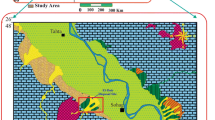Abstract
Electrical Resistivity Tomography (ERT) has been used in association with several geohydrological, geotechnical and geophysical methods in resolving several site specific problems in hydrological science. Advancement in the field of computers and automation in the field of electronics has jointly resulted in the development of this geophysical innovation which has wide application in groundwater, environmental and engineering problems including monitoring of vadose zone water movement, steam injection etc. In this paper application of ERT in association with geohydrological and other exploration methods in resolving groundwater sustainability problem of a micro-watershed area in semi arid granite terrain is presented as three independent cases. In a hard rock terrain the probability of complexities in understanding the sub-surface lithology and its corresponding hydrological parameters are more. Hence appropriate resistivity survey configuration and suitable inversion of acquired data in congregation with other geo-scientific investigations were carried out to understand the site specific problem. The study demonstrated as 3 independent cases shows the usefulness of the ERT method in hydrological investigations, which is economic, efficient and less time consuming in comparison to the other exploration methods.
Similar content being viewed by others
References
Andrade, Rolland (2009) Sustainable Groundwater Development and Quality Management in Nalgonda District — Andhra Pradesh through Integrated Geohydrological and Artificial Recharge Approach. Ph.D Thesis, Osmania University.
Dahlin, T. (1996) 2D resistivity surveying for environmental and engineering applications. First Break, v.14, pp.275–284.
Gangadhar Rao, T. (1999) Training course on Sustainable drinking water source creation through integrated geohydrological approaches — Groundwater Exploration Techniques, National Geophysical Research Institute, pp.1–294.
Griffiths, D.H. and Turnbull, J. (1985) A multi-electrode array for resistivity surveying. First Break, v.3(7), pp.16–20.
Keller, G.V. and Frischknecht, F.C. (1966) Electrical methods in geophysical prospecting. Pergamon Press Inc., Oxford.
Marescot, Laurent (1995) Electrical Surveying Part I: Resistivity method Lecture A. WS0506.
Palacky, G.J. (1987) Resistivity characteristics of geologic targets”. In: M.N. Nabighian (Ed.), Electromagnetic methods in applied geophysics. Soc. Explor. Geophys., Tulsa.
Sabnavis, Murali and Patangay, N.S. (1998) Principles and application of Groundwater Geophysics. Assoc. Explor Geophys, pp. 1–419.
William Daily, Abelardo Ramirez, Andrew Binley and Douglas Labrecque (2004) Electrical Resistance Tomography. The Leading Edge, pp.438–442.
Author information
Authors and Affiliations
Corresponding author
Rights and permissions
About this article
Cite this article
Andrade, R. Intervention of Electrical Resistance Tomography (ERT) in resolving hydrological problems of a semi arid granite terrain of Southern India. J Geol Soc India 78, 337–344 (2011). https://doi.org/10.1007/s12594-011-0100-x
Received:
Accepted:
Published:
Issue Date:
DOI: https://doi.org/10.1007/s12594-011-0100-x




